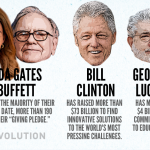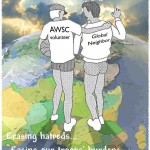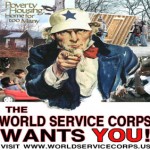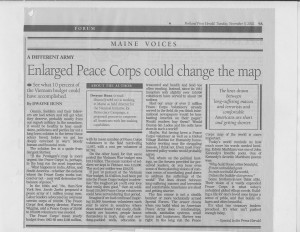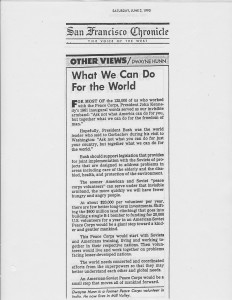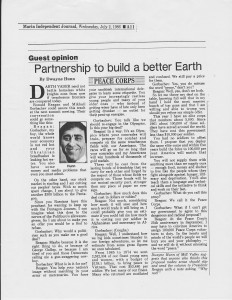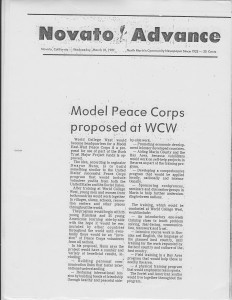Ted draft. Pictures = Powerpoint background.
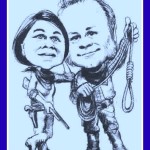
What if…
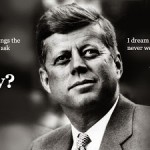
What if… Ed Koupal, People’s Lobby’s co-founder, who revived the initiative process for grassroots organizations, had lived beyond his 48th year in 1976 and continued teaching us his mantra:
“This country runs on laws. If you want to change the country, write its laws.”
What if… John Kennedy had served eight years instead of barely three, and continued inspiring generations with his words:
“And so, my fellow Americans: ask not what your country can do for you–ask what you can do for your country.
My fellow citizens of the world: ask not what America will do for you, but what together we can do for the freedom of man.”
Would this former People’s Lobby and Peace Corps volunteer be “TED asking” you to pester Congress to introduce and enact the American World Service Corps National Service Proposal and field a million Americans a year into peaceful National Service by dramatically expanding the Peace Corps, AmeriCorps, Habitat, Mercy Corps, and other local and national do-good organizations?
During my senior year in college in the mid 60’s, buddies told me that a couple FBI agents were asking questions about me. Fortunately, they did not hover-up that much disparaging information, which led me to spending about 15 hours a day for three months doing Peace Corps Urban Community Development training out of Columbia University, with field training in South Bronx and Harlem. Training was intended to prepare us for the slums of then Bombay, India.
On two of our training sessions from high powered Columbia University professors, I fell asleep.
On one of those occasions I was jolted awake when the professor said, “Fifty percent of India’s beggars are purposefully maimed.”
I asked where he got that statistic. He said, “Government of India.”
I asked, “How does the government of India get that statistic? Do they go around and ask mothers did they maim their kid today?” He didn’t know.
I asked if he had ever been to India. He said no. Know-it-all me cockily rested my case.
Then I went to serve in India.
My first day introduced me to that little girl with the pussy, bloody, jagged hole in the side of her cheek the size of a Kennedy silver dollar.
Near her street beat, I watched armadas of skateboards carrying children and adults with chopped off ankles, knees, hands… using their skateboards to latch onto cars and beg for rupees at Church Gate Railroad Station.
I saw families of four and five living in pipes and cardboard shanties everywhere.
… Stared at beggars with seemingly gouged eyes begging on crowded trains and buses.
… Gave late night rupees to the men eating from 5’ piles of garbage near Bombay’s financial district.
… Stared at the woman lying next to the curb of the bridge over which a thousand people must have tread each hour. She lay on her back, had tattered rags covering part of her breast and had nothing else. I thought she was dead. Maybe I stared for a minute or two, until many people gathered to stare at me.
At a village railroad station, I stared hard at the father until he finally stopped his little daughter from licking her fourth scoop of her own mashed potato consistency diarrhea.
To borrow a few words from national service proponent and First Lady Michelle Obama, this is not, “The world as it should be.”
How can we move closer to a “Should-be world?”
What if… we built a robust, peaceful national service program and incentivized a million Americans aged 18 through 70 + to annually serve by dramatically increasing the size of already proven organizations like the Peace Corps, AmeriCorps, Habitat, Doctors Without Borders, Head Start, Red Cross, International Rescue Committee, Oxfam, Mercy Corps, State Conservation Corps, effective local non-profits, in-need schools, etc.,
What if … AWSC’s volunteers working as full time teachers’ assistants could tutor, mentor, expand Head Start to the other 50% of un-served Head Start children, help at crowded, overburdened physical therapy centers of hospitals, and engage with local community development movements?
What if… this proposed AWSC National Service Proposal required an investment of $700 billion over its proposed legislated life of 27 years to field 21 million Americans doing good at home and abroad?
What if … we took up Nader’s call and benefitted from the Buffet and Gates Giving Pledge movement and publically posted voluntary AWSC spread sheets reflecting what amount the world’s richest, Forbes 400, top celebrities and athletes, biggest corporations, etc., would “voluntarily” give to this escrowed account to underwrite AWSC National Service?
How much would just the Forbes 400 Richest Americans need to invest in “serving Americans” to make a safer, saner world?
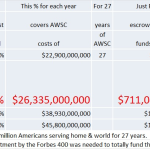
A voluntary annual donation of about 1.15% of “just the Forbes 400’s wealth” would cover the 27 year $700 billion investment in the world’s future.
What if …. This inspired other nations to replicate such a doing-good investment?
We have our troops serving with others in NATO and the UN. Have multi-nation astronauts serving together.
What if… we resurrected Congresswoman Boxer’s People’s Lobby inspired House Resolution 1807 of 1989 and built a US Russian Peace Corps?
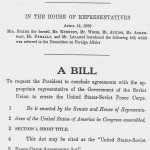
Why not do the same with Japan, Canada, Iran, Cuba… name your country and get the world to start building 21st century, peaceful, development-oriented armies needed to foster diplomacy, build the foundations of peace, and battle climate weirding.
Isn’t it time you asked yourself and Congress that George Bernard Shaw question that Robert Kennedy often borrowed?
“You see things; and you say ‘Why?’
But I dream things that never were; and I say ‘Why not?’”
We have 1.4 million active military doing full-time national service. That’s 4/10th of 1%… or
.44% OR 1 OUT OF 229 Americans doing military national service. Our troops battle a lot. Many come home with PTSD.
Maybe they must battle too much because not enough of the rest of us make the world a friendlier and safer place for them.
Depending on what stats one uses, our Greatest Generation had 33-50+% of their generation doing national service. It is a big part of what made them the Greatest Generation.
Isn’t it time to start building 21st century armies that use their arms to teach, nurse, spread clean energy, build Habitat homes and latrines, and respond to an angered Mother Nature?
Most who serve in our military, Peace Corps, AmeriCorps, or related organizations believe more should serve… So why don’t we use the American World Service Corps National Service Proposal to build those service numbers?
Many congresspersons object to investing tax dollars in do-good projects… But with the AWSC National Service Proposal, in an age of growing financial inequities, we have a non-traditional, voluntary funding mechanism that could fund the whole, or a significant part of, a national service program that could develop a safer and more prosperous world.
Hopefully, you are asking yourself “Why don’t we do this?”
More importantly, hopefully, you will tomorrow and consistently thereafter pester and vote for a Congress that will get more Americans involved in robust AWSC National Service.
Was that butterfly who stung like a bee, Mohammed Ali, right when he said?
“Service to others is the rent you pay for your room here on earth.”
Remember, “If you want to change the country, write its laws.”
And if you want help make some lives better, involve yourself in meaningful service.
Thank you.


